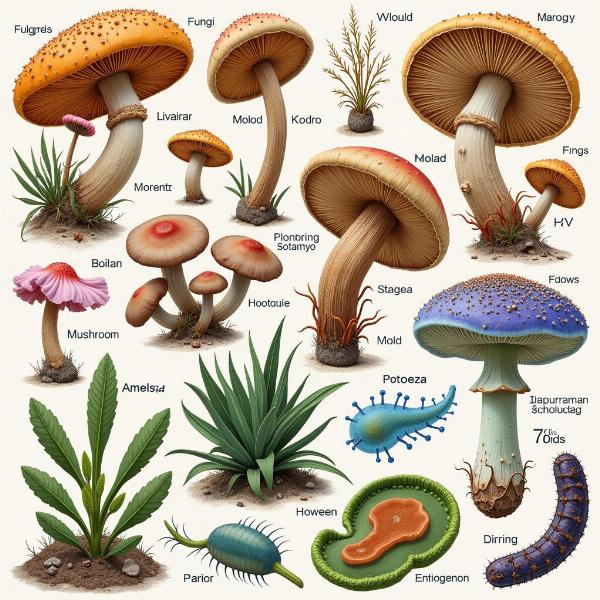Saprozoic nutrition, or saprozoic meaning in hindi, refers to the process by which organisms obtain nutrients by absorbing dissolved organic matter from their surroundings. This fascinating biological process plays a crucial role in various ecosystems, supporting a diverse range of organisms, from microscopic bacteria to larger invertebrates. Understanding the saprozoic meaning in hindi provides valuable insights into the intricate web of life and the diverse ways organisms sustain themselves.
What Does Saprozoic Mean in Hindi?
The Hindi translation for “saprozoic” isn’t a direct, single word equivalent. Instead, it’s generally described as “मृतजीवी पोषण” (mritajeevi poshan), which literally translates to “dead-living nutrition.” This captures the essence of saprozoic nutrition, highlighting the reliance on absorbing nutrients from decaying organic matter. Sometimes, you might also see it referred to as “परजीवी पोषण” (parjeevi poshan), meaning “parasitic nutrition,” although this is less accurate as saprozoic organisms don’t necessarily live on or in another living organism.
Understanding Saprozoic Nutrition: How it Works
Saprozoic organisms secrete enzymes that break down complex organic molecules into simpler, soluble forms. These soluble nutrients are then absorbed across the organism’s cell membrane and utilized for various metabolic processes, including growth, reproduction, and energy production. This process is essential for nutrient cycling in ecosystems, breaking down dead organic matter and returning vital nutrients back into the environment.
Examples of Saprozoic Organisms
Various organisms across different kingdoms exhibit saprozoic nutrition. Many fungi, like mushrooms and molds, obtain nutrients from decaying wood and leaves. Certain protozoa, such as amoebas, also employ saprozoic nutrition, absorbing dissolved nutrients from their aquatic environments. Even some bacteria are saprozoic, playing a crucial role in decomposing organic waste.
 Examples of Saprozoic Organisms
Examples of Saprozoic Organisms
Saprozoic vs. Other Modes of Nutrition
It’s important to distinguish saprozoic nutrition from other similar modes of nutrition, like parasitic and holozoic nutrition. Parasitic organisms obtain nutrients from living hosts, often harming the host in the process. Holozoic organisms, on the other hand, ingest solid food particles and digest them internally. Saprozoic organisms, unlike the other two, rely solely on absorbing dissolved organic matter.
What are the benefits of understanding “saprozoic meaning in hindi”?
Understanding “saprozoic meaning in hindi” helps us appreciate the interconnectedness of life and the essential role these organisms play in maintaining ecological balance. It also has practical implications in fields like agriculture and waste management, where understanding decomposition processes is crucial.
Conclusion
Saprozoic nutrition, or saprozoic meaning in hindi as “मृतजीवी पोषण,” is a vital process in ecosystems, facilitating the breakdown of organic matter and nutrient cycling. This unique mode of nutrition supports a diverse array of organisms, playing a crucial role in maintaining ecological balance. Understanding this concept deepens our appreciation for the intricate web of life and the fascinating ways organisms thrive.
FAQs
- What is the exact Hindi translation of “saprozoic”? As explained earlier, there’s no single word equivalent. “मृतजीवी पोषण” (mritajeevi poshan) is the most accurate descriptive translation.
- Are all fungi saprozoic? No, while many fungi are saprozoic, some are parasitic or even symbiotic.
- Where do saprozoic organisms live? They can be found in various environments rich in organic matter, such as soil, water, and decaying plant and animal matter.
- What is the difference between saprozoic and saprophytic nutrition? Saprophytic nutrition specifically refers to plants or plant-like organisms obtaining nutrients from dead organic matter, while saprozoic refers to animals or animal-like organisms doing the same.
- Why are saprozoic organisms important? They are essential decomposers, breaking down complex organic matter and releasing vital nutrients back into the environment.
- How do saprozoic organisms contribute to nutrient cycling? By breaking down dead organic matter, they release nutrients back into the soil and water, making them available for other organisms.
- Can saprozoic organisms be harmful? Some can cause food spoilage or certain diseases, but most are beneficial to the environment.
Meaning-Hindi.in: Your Expert Hindi Translation Partner
Meaning-Hindi.in is your one-stop solution for all your Hindi translation needs. We offer a wide range of professional translation services, specializing in business, legal, technical, website localization, educational, and urgent translations. Our team of expert Hindi linguists ensures accurate and culturally sensitive translations, tailored to your specific requirements. Whether you need to translate documents, websites, or any other content, Meaning-Hindi.in is committed to delivering high-quality translations that bridge the language gap. Contact us today at [email protected] or call us at +91 11-4502-7584 to discuss your project. Meaning-Hindi.in – bridging cultures, connecting worlds.